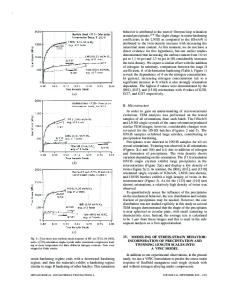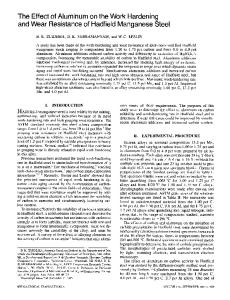The effect of twinning and slip on the bauschinger effect of hadfield steel single crystals
- PDF / 1,258,026 Bytes
- 12 Pages / 612 x 792 pts (letter) Page_size
- 97 Downloads / 335 Views
I. INTRODUCTION
THE interest in the work-hardening mechanisms of metals deforming by twinning and slip has been continuously increasing in recent years. To establish relationships for describing the complex response of metals in service conditions, Bauschinger experiments have proved valuable. Johann Bauschinger[1] was the first who examined steels through a series of successive tension and compression loading applications and demonstrated the lowering of the yield point during reverse deformation. To date, almost all Bauschinger studies have focused on dispersion-hardened alloys that exhibit a large Bauschinger effect (BE).[2–6] There are also other studies on pure metals, such as Cu and Al,[3,7] on steels,[8] and on low stacking fault energy (SFE) metals, such as Cu-Al.[9] According to the aforementioned studies, the observed BE is caused by the development of internal stress during forward loading. This stress serves as a back stress that resists the dislocation motion in forward straining while assisting the deformation during the reverse straining. Although back stresses mostly originate from Orowan shear loops around dispersoids, it has been shown that dislocation tangles can act as hard but deformable barriers in a IBRAHIM KARAMAN, formerly Research Associate, Department of Mechanical and Industrial Engineering, University of Illinois, is Assistant Professor, Department of Mechanical Engineering, Texas A & M University, College Station, TX 77843. HUSEYIN SEHITOGLU, Grayce Wicall Gauthier Professor, is with the Department of Mechanical and Industrial Engineering, University of Illinois, Urbana, IL 61801. Y.I. CHUMLYAKOV, Professor, and I.V. KIREEVA, Research Scientist, is with the Siberian Physical-Technical Institute, Tomsk 634050, Russia. HANS J. MAIER, Professor, is with the University of Paderborn, Lehrstuhl f. Werkstoffkunde, (Materials Science), D-33095 Paderborn, Germany. Manuscript submitted February 21, 2000. METALLURGICAL AND MATERIALS TRANSACTIONS A
relatively soft matrix.[7] Moreover, the characteristics of the dislocations can be another major factor in the BE, according to Abel and Muir.[9] The studies on the BE and the relative roles of workhardening mechanisms have been mostly focused on materials that deform only by slip. To our knowledge, no detailed Bauschinger studies have been reported that elucidate the relative importance of twinning and slip and their interaction. Therefore, the current work will clarify the role of twinning on the BE of Hadfield manganese steels. Hadfield steel is a stable austenitic steel with nominal manganese and carbon compositions of 12 to 14 pct and 1.0 to 1.3 pct, respectively. It is characterized by a high strainhardening (upward stress strain) curve and by the absence of a recovery regime typical of Al and Cu alloys. Recently, the authors[10] demonstrated orientation dependence and tension-compression asymmetry in deformation mechanisms and strain-hardening behavior under uniaxial loading. It was shown that the primary reason for the upward curvature in str
Data Loading...











